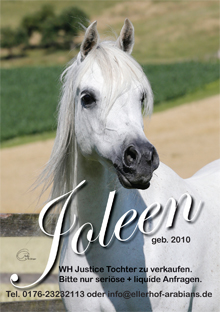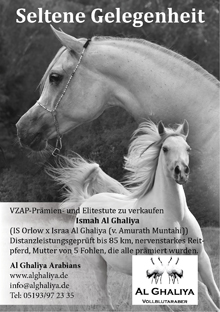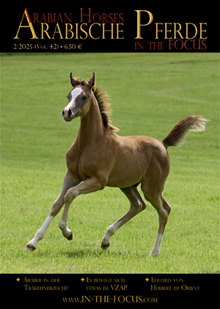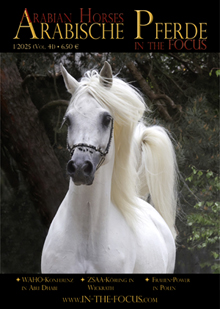Some purity fanatics claim that the majority of Arabian horses are impure, that they are Partbreds, mongrels, etc. It all boils down that although we are using the same words, i.e. “Purebred Arabian”, we have different underlying definitions in mind. So let’s have a look at the question “what is a purebred Arabian”?
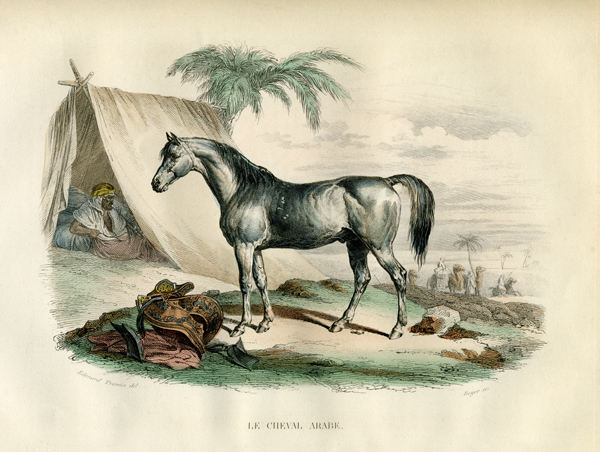
In all this discussion about the “purebred Arabian”, it appears to me, that we are stuck in a Tower of Babylon, with people talking in different languages. If we want to discuss a matter, we have to find a common language. As matters get more complicated we even need to know the connotation of the words, i.e. their different meaning due to the different cultural background of the person using it. In our case, when discussing the “purebred Arabian horse”, the common language is the definition of the terms “breed” and “purebred”, into which we have to look first.
The Western Approach
Our Western concept of “breeds” is quite a recent one and only about 200 years old. In the old days, horse breeds were defined and named by geography, i.e. where they came from, for example the Icelandic Pony, the Frisian, the Arabian horse. Today, horse breeds are defined by their respective breeder’s society (registry). The registry keeps the genealogical records (pedigrees, studbooks) and establishes rules, e.g. for the eligibility to the studbook, for competitions, etc. When a horse is descended from parents that belong to this registry, it is considered to be purebred. The most famous registry is the GSB (General Stud Book), established for the English Thoroughbred. I think it is commonly accepted, that the English Thoroughbred is a “pure breed”. Yet, at the beginning there were some “native English mares”, and some Barb, Turcoman and Arabian stallions. And out of a blend of different breeds emerged a “pure breed”. It is important to understand that “purebred” or “pure breed” is an administrative definition, not a genetic one! And a breed name is just a definition, an agreement among breeders.
So let’s have a look at WAHO (World Arabian Horse Organisation), the umbrella organisation of “Arabian horse registries” worldwide, and its definition of a “purebred Arabian horse”. It says: “A Purebred Arabian horse is one which appears in any purebred Arabian Stud Book or Register listed by WAHO as acceptable.” This list includes today some 63 registries (studbooks) and about 20 more countries that are registering under the supervision of one of these 63. This definition defines that any horse that has been registered in a WAHO-accepted studbook, is by definition a purebred Arabian horse, and therefore the WAHO-definition fits exactly into the purebred-definition as described before. This “circular” definition is accepted by all the 80+ breed registries, and as such by all breeders that breed purebred Arabians as defined by WAHO, which I imagine is around 95 % (or more) of all Arabian horse breeders worldwide.
Many other ideas are present among Arabian horse enthusiasts, for example the notion of “purity of blood” and “tracing in every line to the deserts of Arabia”. I therefore would like to look at this issue by differentiating several different concepts:
a) the “purebred” and “pure breed concept” in modern animal breeding,
b) the “purity of blood concept based on tradition, culture and religion” as transmitted in the Bedouin narrative,
c) the “purity of genes” based on modern genetics.
Modern Animal Breeding
The “purebred” concept in modern animal breeding was briefly outlined above and boils down to an administrative definition. No matter, what kind of horses were at the beginning of registration, once the horse is accepted into the studbook, his offspring are considered as belonging to the breed in question. When we look back some 200 years, at the time when the first European studs with Arabian horses were established, there were no breed registries for Arabians. There were some book authors and other experts, but none had any authority to define the breed. Basically, each stud kept its own studbook or breeding records and it was up to the individual breeder to define an Arabian horse and it was up to this individual breeder’s reputation, whether or not others would believe him. If such a breeder would say: “This is an Arabian horse”, it was his understanding of an Arabian horse, even if today (!) some people would define it differently.
During the last 100 years, breed associations were established in various European countries. The “Arab Horse Society” of Great Britain was founded in 1918 and is therefore one of the oldest. Before, Arabian horses were commonly registered with the GSB, usually in a separate section, a practice that was also common in other countries (France, Austria, Germany). More and more countries established a breed society specifically for the Arabian horse, but each of them with different rules and different breed definitions – especially with regards to origin and purity, etc. Therefore it happened that the one country would not accept and register horses from another country. This was a major obstacle for international trade. To end this situation, WAHO was founded in 1972, when its constitution was ratified. At the time, the WAHO Definition merely stated that the horses existing in these seven countries (with well-known and long-standing Arabian stud books) prior to January 1, 1972, were considered to be purebred Arabian horses. Yet, it should not be concealed that some horses were under suspicion of not being “pure”, or not “tracing back in all lines to the deserts of Arabia”, but they had been registered in the reciprocally accepted studbooks and therefore came under the initial definition. Later, the present WAHO definition was developed. In any case, establishing the WAHO definition was a major step forward for international trade, export and import.
Tradition, Culture and Religion
Despite of that technical definition, there are many romantic stories about the Arabian horse, its origin, its breeders and breed history and many of today’s breeders seem to prefer these stories over the naked facts.
Let’s summarize these stories under the “purity of blood concept based on tradition, culture and religion” as transmitted in the Bedouin narrative. It is a very different approach and based on oral transmission of knowledge, on religious belief of what is allowed and not allowed and on the integrity of the breeders. Furthermore, it depends on the social control in the communities and Bedouin tribes that ensures that these cultural and religious rules are upheld. It appears to be logic that this concept (as we know it) only emerged after Islam was established on the Arabian Peninsula, as the religion of Islam is part of the purity and breeding concept. It is also clear, that the “purity by tradition concept” has its validity only within this cultural and religious frame and for any outsider there is room for suspicion and speculation.
Part of this concept was brought to Europe with some Orient travellers in the 18th and 19th century. They told a romanticised story of the Bedouin tribes that bred the Arabian horse for centuries, kept it pure thanks to their religion and cultural traditions. And whatever is true about this story is only valid until the beginning of the 20th century. Because, in the same way, the Bedouin gave up their lifestyle, in the same way the motor car replaced the horse and the rifle the lance, the Arabian horse lost its “raison d’etre” in these countries. When oil was discovered, the interest of the majority of people shifted from the Bedouin life style to modern life style and the number of horses dropped dramatically. An increase in the importance of racing as a sport did the rest and the influence of English Thoroughbreds is not a phenomenon of modern times! Luckily, few breeders with old autochthonous (i.e. original, indigenous) bloodlines remained in these countries, notably in Syria, Iran, Bahrain and Saudi Arabia. Even though hardly any of them maintained the Bedouin lifestyle, they kept on breeding their horses as a family tradition. Let’s call them preservation breeders in the best of terms.
Starting around 1980is and 90ies, the Arabian horse saw a renaissance in the countries of the Middle East, when several people (mostly rich Sheikhs) had discovered the Arab horse as part of their cultural heritage and re-imported horses from the West. However, their “original heritage”, i.e. the autochthonous populations, did not play a major role, because the “new Arab horse breeders” adhered to the universally accepted WAHO-definition and mainly imported modern bloodlines for the show ring and the race track. This trend has been maintained basically until today.
Modern Genetics
Neither the “purity of blood concept based on tradition, culture and religion” nor the “breed concept” is scientific proof, of which horse genetically belongs to the Arabian breed and which doesn’t; both are cultural and/or social agreements. To cover the scientific aspect, we will have to switch over to DNA (see also „Purity from a genetic view point” in this issue).
Much research has been done recently to understand the phylogenetic tree of the various horse breeds. A current hypothesis maintained by Wallner et. al. stipulates that the Oriental breeds originate from an ancient horse population called the “Crown Group” some 1500 years ago. This is basically the ancestral population of horses from which the Arabian, Turcoman and Barb breeds emerged.
The scientific basis for this phylogenetic tree is based on haplotypes (i.e. group of genes inherited together from a single parent) located on the Y-chromosome, which is transmitted in the paternal line only. However, this Y chromosome strains our imagination, because it means that all male horses go back to one (!) ancestor. In the case of the Oriental breeds, this male ancestor lived around 1500 years ago. Of course, there were many other horses around him, living in the same space and time, but only his male line lived on into the future. The other horses, however, may be found in the “autosomal chromosomes” of today’s horses. Now, if all (male) horses of the Oriental breeds (i.e. Arabians, Turcomans and Barb horses), have one common male ancestor, the one from which each of our Arabian stallions today got his Y-chromosome, what does that mean in terms of “purity”? It means that all these breeds share some common genetic material. And if we consider that they were all bred by nomadic people in a semi-arid environment, the similarities outweigh the differences, and it should not come as a surprise that the Arabian horse shares some genes with the Turcoman breed.
Modern genetics has given us some insight into the genetic outfit of the Oriental horse. To have this data is one thing, the interpretation of this data is quite another. Unfortunately, this data has already been misinterpreted by people without the necessary expertise. Others are jumping to conclusions, or have an agenda of their own which they try to support with the data – all of this is rather dangerous! One needs to understand that the haplotypes are not by themselves a “genetic breed definition” – it is still us humans who define “who is in and who is out”. If we use modern genetics to define which horses are acceptable as “purebred Arabian” and which are not, we have to decide which horses we use as reference group? And who will define the reference group? Again and again, it will be a man-made definition of what is an Arabian horse!
Pure, purer, purest
The whole discussion about “purity” has reached a degree of fanaticism with which some groups defend and uphold the myths and legends surrounding the origins and purity of the Arabian horse that it has become counterproductive to the breed’s reputation.
As we have seen, the whole issue about breed name and purity is a manmade definition. So why can’t we agree that all these WAHO-accepted horses are called “purebred Arabian horses” by definition, while some preservation groups may call theirs “Straight Egyptian”, “Asil Arabians”, “Bedouin horses” or “Desertbreds”. Everyone is free to come up with another subgroup and define this group of bloodlines, whether within or outside the “purebred Arabians”, which is nothing more than a technical term, a convention, a definition. The WAHO Definition once was put in place to close the door on all the skeletons in all the closets and to stop the fingerpointing and mud-slinging (‘mine’s pure, yours is not’). So, instead of fighting each other within the Arabian horse community, let’s rather enjoy our horses of this international, man-made breed.
Gudrun Waiditschka








